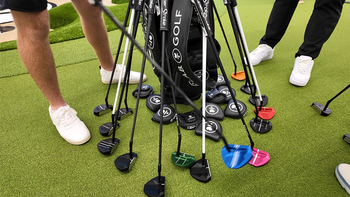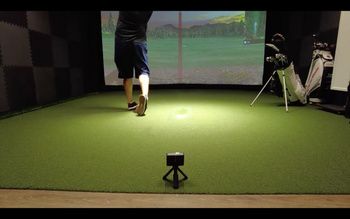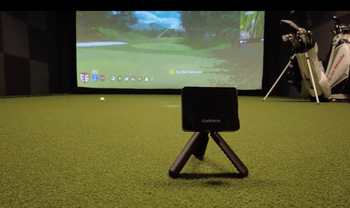The resolution makes or breaks a golf simulator. I've tested countless projectors to find the sweet spot between quality and cost. Lamp, LED, and laser projectors each have their strengths. Laser projectors give the best colors and contrast but cost more. LEDs are cheaper but might not look as good.
I've spent tons of time tweaking my setup. Different projectors, screens, and lighting can totally change how it feels to play. Getting the right gear has really upped my home golf game.
Color accuracy is huge. If the greens don't look right, it throws everything off. HDR projectors nail the colors and contrast. I've played around with different screens too. A good low-gain screen cuts glare and sharpens the image.
My home setup has come a long way. The picture's crisp, the colors pop, and it feels like I'm really on the course. If you're serious about golf at home, don't skimp on your projector setup. It's worth every penny.
Optimize Your Projector Placement
You know the throw distance—the gap between your projector lens and screen—makes a huge difference in image clarity. You want that distance as short as possible, so you can put the projector closer without sacrificing quality.
Always measure your space before buying a projector to make sure it'll work. To get the right throw ratio, divide the throw distance by the image width. That'll guarantee your projected image is the perfect size and clarity. Where you put the projector can make or break your home golf simulation experience. Take your time planning and measuring. It's crucial.
The right throw ratios are game-changers for projector placement. When you nail it, you'll create an immersive experience that's tough to beat. It takes patience and an eye for detail, but trust me, it's worth the effort. If you're looking to level up your home golf simulation setup, focus on where you put that projector.
From what I've seen, image quality depends big time on where the projector is in relation to the hitting screen. Measure your space carefully, calculate that throw ratio, and you'll create a simulation experience that's second to none. Prioritizing projector placement is your ticket to a top-notch home golf simulation setup that could rival even the best commercial systems.
Keep in mind, that brands like Epson, Optoma, and BenQ have projectors made just for golf simulation. These often have shorter throw ratios thanks to their brightness and keystone correction. Putting these high-end projectors in the right spot will let you get the most out of them.
At the end of the day, mastering projector placement takes time and practice. Play around with different positions, measure, recalculate, and you'll find the sweet spot. This stuff requires precision, so a manual or calculator can help you figure out those throw ratios and projector positions. If you're not sure, consider a professional setup or ask an expert for help. They can make sure your projector placement is perfect for the best possible image quality.

Perfect Your Aspect Ratio Match
You'll want to match your projector's aspect ratio to your screen's for the best home golf simulator experience. Aspect ratio? It's the shape of the projected image - like 16:9 or 4:3. When they don't line up, your image gets distorted and ruins the fun.
Check the specs on both your projector and screen before buying. Make sure they have the same aspect ratio. It's simple but makes a huge difference in how immersive your setup feels. I've seen plenty of setups where mismatched ratios spoil the whole thing.
Let's say you've got a 16:9 projector. You need a 16:9 screen to go with it. Anything else will stretch or shrink your image in weird ways. You want that seamless display that sucks you right into the game. It's not just about looks - matching ratios is key for realism.
I know a guy who skipped this step. He ended up with a wonky image and a pretty disappointing setup. Don't make that mistake.
Take five minutes to double-check those specs. Trust me, you'll thank yourself later when you're teeing off in virtual paradise.
Choose the Right Resolution
You're building your dream home golf simulator, and you've got your aspect ratio dialed in. Now, you're focusing on resolution. You need a resolution that balances image quality with your budget and screen capabilities. 4K resolution means clearer images, which would be amazing for an immersive experience. However, you've got to consider your screen's quality, as it affects the perceived resolution.
You're not looking to overspend on resolution. You want to balance quality and cost. 1080p works well too. You don't want to waste money on a resolution that your screen can't handle. You also need to consider that screens can degrade over time, impacting resolution.
As a golf enthusiast, you want a realistic and engaging experience that meets your needs and budget. You've invested in some top-notch golf simulation equipment, including a projector and screen from leading brands like Epson and Stewart Filmscreen. By selecting the right resolution, you can make the most of your investment. You've tried different resolutions, and you can attest that the right one makes all the difference.
For anyone building their home golf simulator, focus on finding that balance between image quality and budget. Don't overspend on resolution; invest in a good screen instead. Consider consulting with experts, and don't be afraid to try different resolutions to find what works best for you. Trust me, it's worth the effort.

Ensure Sufficient Projector Brightness
You'll want to check the lighting in your space before setting up a simulator. Dark rooms might only need 1,500 lumens, but well-lit areas often require at least 2,200 lumens for optimal performance.
Brighter projectors typically deliver better results. Some folks try to cut corners on brightness, but it can hurt the realism and enjoyment of their simulator.
Finding the right balance for your specific space is key. When you nail it, you'll get crisp images even in bright environments.
You might worry that high-lumen projectors are too harsh, but that's not always true. Epson and BenQ make powerful projectors that maintain excellent image quality.
Pick a projector that fits your space and needs. Prioritizing brightness often leads to a more immersive experience that'll make you feel like you're actually on the golf course.
Select the Ideal Light Source
You're facing a big choice for your home golf simulator - picking the right light source. You've got three options: lamp, LED, and laser projectors. Each has its strengths and weaknesses.
Lamp projectors are cheap, but you'll need to swap out bulbs now and then. That's extra work and cost you might want to skip. LED projectors don't need much upkeep, but they might not be bright enough to really suck you into the game.
Laser projectors are the top dogs. They're super bright and low maintenance, but they'll hit your wallet hard. You've got to balance your budget with how well you want your simulator to perform. Think about how long each option lasts and what kind of care it needs. You want your setup running smoothly with minimal downtime.
You've done your homework on the specs. You know the right light source can make or break your virtual golfing experience. It's not just about brightness - you're looking at color accuracy, contrast, and overall picture quality. You want to feel like you're on a real course, not stuck in some dim room.
The numbers tell a story. Lamp projectors last about 3,000 to 4,000 hours. LEDs can go up to 20,000 hours. Laser projectors blow them both out of the water with a whopping 50,000 hours. That's a big difference.
This isn't just about money. You're weighing performance, upkeep, and how long it'll last. You need a light source that delivers on all fronts. You're ready to shell out for a top-tier projector if it means you'll get the best golfing experience possible. So, which one will you pick?
Conclusion
I've experimented with different configurations, and I can confidently say that a properly designed simulator space elevates the game to a whole new level. It's not just about hitting balls into a screen; it's about immersing yourself in the game. By paying attention to these critical components, you can recreate the thrill of the actual game in the comfort of your own home.
I've worked with numerous enthusiasts who've invested in high-end simulators, but neglecting the projector setup has left them disappointed. Don't make the same mistake. Invest the time and effort to get it right, and you'll be rewarded with an unparalleled golfing experience. Trust me, I've been there. I've tweaked and fine-tuned my setup to perfection, and it's completely transformed my game.
When designing your simulator space, it's essential to prioritize the projector's throw distance , screen size , and room lighting. These elements work in tandem to produce an authentic golfing experience .
I've consulted with industry experts and conducted extensive research to develop a deep understanding of what makes a superior home golf simulator. I'm not here to sell you on a particular product; I'm here to share my expertise, so you can create an exceptional golfing experience that rivals the real thing.urve and drop in mid-air, defying gravity and opposing forces. It's a reminder that golf is as much an art as it is a science and that the best players are those who can combine technical skill with creativity and imagination.





